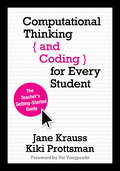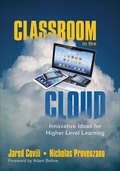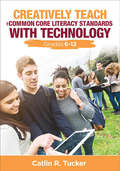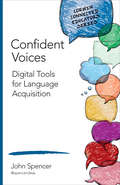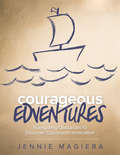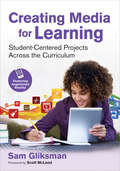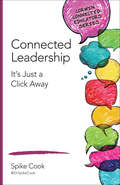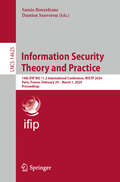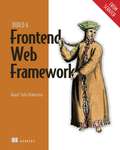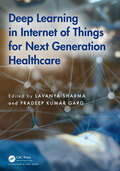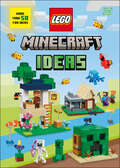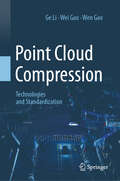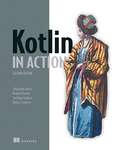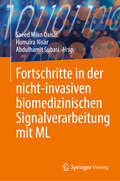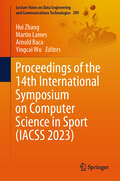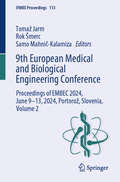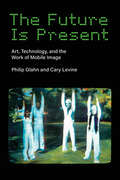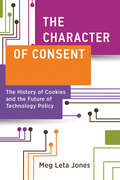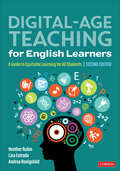- Table View
- List View
Computational Thinking and Coding for Every Student: The Teacher’s Getting-Started Guide
by Jane Krauss Kiki ProttsmanEmpower tomorrow’s tech innovators Our students are avid users and consumers of technology. Isn’t it time that they see themselves as the next technological innovators, too? Computational Thinking and Coding for Every Student is the beginner’s guide for K-12 educators who want to learn to integrate the basics of computer science into their curriculum. Readers will find Practical strategies for teaching computational thinking and the beginning steps to introduce coding at any grade level, across disciplines, and during out-of-school time Instruction-ready lessons and activities for every grade Specific guidance for designing a learning pathway for elementary, middle, or high school students Justification for making coding and computer science accessible to all A glossary with definitions of key computer science terms, a discussion guide with tips for making the most of the book, and companion website with videos, activities, and other resources Momentum for computer science education is growing as educators and parents realize how fundamental computing has become for the jobs of the future. This book is for educators who see all of their students as creative thinkers and active contributors to tomorrow’s innovations. "Kiki Prottsman and Jane Krauss have been at the forefront of the rising popularity of computer science and are experts in the issues that the field faces, such as equity and diversity. In this book, they’ve condensed years of research and practitioner experience into an easy to read narrative about what computer science is, why it is important, and how to teach it to a variety of audiences. Their ideas aren’t just good, they are research-based and have been in practice in thousands of classrooms…So to the hundreds and thousands of teachers who are considering, learning, or actively teaching computer science—this book is well worth your time." Pat Yongpradit Chief Academic Officer, Code.org
Classroom in the Cloud: Innovative Ideas for Higher Level Learning
by Jared Covili Nicholas ProvenzanoThe sky’s not the limit anymore—get your head in the cloud! Making the most of the digital age in education just got easier. With cloud computing, students can connect with teachers, educators can connect with colleagues, and opportunities for meaningful collaboration can grow exponentially. In this easy-to-use primer, the author of bestseller Going Google teams up with Twitter’s The Nerdy Teacher to demonstrate what cloud-based instruction can mean for teachers and students—and how it can work for your school. The book includes Practical tools for integrating cloud computing into the curriculum Student and teacher testimonies detailing examples of cloud-based instruction in action Chapters on storing, communicating, sharing, and creating Strategies for ensuring safety and security for students and information "This book provides direct quotes from teachers and students about amazing cloud-based applications. You’ll find innovative tools and practices, step-by-step instructions for implementation, and an array of tools for all grade levels and subjects. The classroom may now be in the cloud, but this book will be at my side anytime I need tech tools that are creative, easy-to-use, and fun for teaching and learning." Mark Barnes, Author of Teaching the iStudent and 5 Skills for the Global Learner "It’s more important today than ever before for educators to look beyond the walls of classrooms and connect with other colleagues in their buildings and across the globe. This book will equip all educators with the tools necessary to find the best tools to enhance and improve their teaching practices." Steven Anderson, Author, The Relevant Educator and Content Curation, @web20classroom
Creatively Teach the Common Core Literacy Standards With Technology: Grades 6-12 (Corwin Teaching Essentials)
by Catlin R. TuckerLet technology pave the way to Common Core success. Your transition to the Common Core just got easier! When you start getting creative with technology, you’ll turn your classroom into a student-centered learning environment that fosters collaboration, individualizes instruction, and cultivates essential technological literacy. This book is your road map to student success—while meeting the Common Core ELA and literacy standards. Features include: Specific recommendations for free apps and tech tools that support the Common Core Step-by-step guidelines to breaking down a Common Core standard for your grade and subject Teacher-tested, lesson ideas and teaching strategies Replicable resources, including prewriting activities and writing templates Real-life examples You don’t need to be in a 1:1 school to do amazing things with technology. With just a few devices, you can engage a whole class! Delve into the Common Core ELA standards by having students experiment creatively with the tech tools at hand for a more meaningful and resonant learning experience. "The book contains a tremendous collection of actionable ideas that can be seamlessly implemented to make a difference in all aspects of the classroom. A must-own guide that will surely be a teacher′s go-to resource to help bring the standards to life." Adam Bellow, Founder of eduTecher / eduClipper Plainview, New York "Catlin Tucker provides great ideas for student use of technology tools that cross the curriculum areas and allow the students to showcase their mastery of content. Students will love how the traditional classroom assessments are transformed!" Kathy Schrock, Educational Technologist, Adjunct Instructor Wilkes University, PA
Confident Voices: Digital Tools for Language Acquisition (Corwin Connected Educators Series)
by John T. SpencerEngage your ELL students through technology! When it comes to technology integration, don’t overlook the needs of your ELL students. Introduce project-based learning into your classroom and utilize strategies to engage your ELL students and bridge the growing divide between technology and the ELL students that need it to thrive. Connected Educator John Spencer shows ELL educators how to combine technology with teaching in this easy-to-use guide to blended learning. Get ready to: Blend innovative technology with project-based learning Strengthen your students’ English language skills Engage your students through the intentional integration of digital tools The Corwin Connected Educators series is your key to unlocking the greatest resource available to all educators: other educators. Being a Connected Educator is more than a set of actions: it’s a belief in the potential of technology to fuel lifelong learning."John Spencer is the kind of teacher that I wish my own kids had and that all students deserve. This book shows clearly and practically how technology can be used to give all students greater choice and a more powerful voice. This book inspired me to rethink my own approach and what I′m planning to do in my classroom tomorrow." Philip Cummings, 6th Grade Teacher Presbyterian Day School "Spencer provides a clear framework for teachers to help students improve their language skills. A teacher can pick this book up and be provided with specific ideas and techniques which can be implemented in a classroom immediately." Josh Stumpenhorst, Teacher Lincoln Junior High School Naperville, IL
Courageous Edventures: Navigating Obstacles to Discover Classroom Innovation (Corwin Teaching Essentials)
by Jennie MagieraChart a course to innovation using educational technology Let’s go on an edventure! Do you want to innovate and take risks in your teaching? Looking for ways to troubleshoot common classroom challenges? Whatever obstacles you and your students face can turn into edventures, and this book will show you how to navigate them with grace, humor, and grit. Jennie Magiera charts a course for you to discover your own version of innovation, using the limitless possibilities of educational technology. You will learn: How to create your own Teacher-IEP (Innovation Exploration Plan) Keys to problem-based innovation (PBI) Strategies and solutions for tackling common classroom problems Methods for putting learning into the hands of students How to find innovation in everyday places Packed with real-world, immediately applicable solutions to the problems teachers face in their classrooms every day,Courageous Edventures shows how technology can be a fun and easy tool to improve classroom management and student learning! "Magiera leads people on a journey with some great ideas to get started in the classroom right now, or the inspiration to find your own way, leading to innovative ideas for learning and teaching." George Couros, Author of The Innovator′s Mindset and Innovative Teaching, Learning, and Leadership Consultant "This book does a superb job of providing practical ideas and strategies on how to actually implement innovative practices in today′s classroom. Her knowledge and experience as a change agent further strengthen the techniques presented and will help educators truly envision what′s possible in classrooms today." Eric Sheninger, Corwin Author and Senior Fellow International Center for Leadership in Education
Courageous Edventures: Navigating Obstacles to Discover Classroom Innovation (Corwin Teaching Essentials)
by Jennie MagieraChart a course to innovation using educational technology Let’s go on an edventure! Do you want to innovate and take risks in your teaching? Looking for ways to troubleshoot common classroom challenges? Whatever obstacles you and your students face can turn into edventures, and this book will show you how to navigate them with grace, humor, and grit. Jennie Magiera charts a course for you to discover your own version of innovation, using the limitless possibilities of educational technology. You will learn: How to create your own Teacher-IEP (Innovation Exploration Plan) Keys to problem-based innovation (PBI) Strategies and solutions for tackling common classroom problems Methods for putting learning into the hands of students How to find innovation in everyday places Packed with real-world, immediately applicable solutions to the problems teachers face in their classrooms every day,Courageous Edventures shows how technology can be a fun and easy tool to improve classroom management and student learning! "Magiera leads people on a journey with some great ideas to get started in the classroom right now, or the inspiration to find your own way, leading to innovative ideas for learning and teaching." George Couros, Author of The Innovator′s Mindset and Innovative Teaching, Learning, and Leadership Consultant "This book does a superb job of providing practical ideas and strategies on how to actually implement innovative practices in today′s classroom. Her knowledge and experience as a change agent further strengthen the techniques presented and will help educators truly envision what′s possible in classrooms today." Eric Sheninger, Corwin Author and Senior Fellow International Center for Leadership in Education
Creating Media for Learning: Student-Centered Projects Across the Curriculum
by Sam GliksmanHelp Students Show Learning Through Media Creation Education hinges on effective communication. This book demonstrates how media has become a core component of modern communication and highlights the need to incorporate student-centered media projects throughout the curriculum. Self-expression with media will enhance the learning process and allow students to creatively demonstrate their knowledge. The strategies and tactics these pages offer equip educators to make their students enthusiastic experts at producing dynamic media projects. Content includes: The how, why, and when of prompting students to create their own media across subjects and grade levels. Keys to mastery of media formats from simple photography to eBooks to complex animations. Detailed descriptions of student projects that utilize different media. The benefits of media sharing, and how to do it responsibly. The innovative use of Augmented Reality, so readers can activate a video on the book’s printed pages with their mobile devices. Across all disciplines, mastery of media creation is central to the success of current and next generation students. Educators who implement this book’s ideas will be amazed by the resultant increase in student engagement and depth of learning. "What a thoughtful collection of student-created products. This book highlights a variety of multimedia projects, offers a multitude of best practices and practical implementation tips, and is sure to empower teachers to help students find their voice." Lisa Johnson, Eanes ISD Ed Tech @TechChef4u
Computational Thinking and Coding for Every Student: The Teacher’s Getting-Started Guide
by Jane Krauss Kiki ProttsmanEmpower tomorrow’s tech innovators Our students are avid users and consumers of technology. Isn’t it time that they see themselves as the next technological innovators, too? Computational Thinking and Coding for Every Student is the beginner’s guide for K-12 educators who want to learn to integrate the basics of computer science into their curriculum. Readers will find Practical strategies for teaching computational thinking and the beginning steps to introduce coding at any grade level, across disciplines, and during out-of-school time Instruction-ready lessons and activities for every grade Specific guidance for designing a learning pathway for elementary, middle, or high school students Justification for making coding and computer science accessible to all A glossary with definitions of key computer science terms, a discussion guide with tips for making the most of the book, and companion website with videos, activities, and other resources Momentum for computer science education is growing as educators and parents realize how fundamental computing has become for the jobs of the future. This book is for educators who see all of their students as creative thinkers and active contributors to tomorrow’s innovations. "Kiki Prottsman and Jane Krauss have been at the forefront of the rising popularity of computer science and are experts in the issues that the field faces, such as equity and diversity. In this book, they’ve condensed years of research and practitioner experience into an easy to read narrative about what computer science is, why it is important, and how to teach it to a variety of audiences. Their ideas aren’t just good, they are research-based and have been in practice in thousands of classrooms…So to the hundreds and thousands of teachers who are considering, learning, or actively teaching computer science—this book is well worth your time." Pat Yongpradit Chief Academic Officer, Code.org
Connected Leadership: It’s Just a Click Away (Corwin Connected Educators Series)
by Spike C. CookYou’re at the top—but never alone! Take the leap and connect with other educators and leaders through social media. Educators learn to transform relationships with their students, staff, parents, and with the overall community in this simple guide to social media. With real-life examples from K12 educators who’ve integrated social media technology and education, this guide helps educators to harness the power of connectedness and change the way you lead. Jump in and you’ll learn how to: Develop a personal learning network Tell your school’s story through blogging Use connections to transform your leadership The Corwin Connected Educators series is your key to unlocking the greatest resource available to all educators: other educators. Being a Connected Educator is more than a set of actions: it’s a belief in the potential of technology to fuel lifelong learning. "This book has practical examples of how educators can use Web 2.0 tools to grow professionally and personally. Cook describes his journey as a lead learner in a way that is easy to read; he inspires, engages, and encourages the reader to move from isolation to connection." Dwight Carter, Principal New Albany High School "After reading this book, you′ll be inspired by the stories of newly connected educators. If you′ve been hesitant to take the plunge into the social media waters, you′ll be ready to jump right in after this quick and informative read." Erin Klein, Teacher and Blogger Kleinspiration
Creating Media for Learning: Student-Centered Projects Across the Curriculum
by Sam GliksmanHelp Students Show Learning Through Media Creation Education hinges on effective communication. This book demonstrates how media has become a core component of modern communication and highlights the need to incorporate student-centered media projects throughout the curriculum. Self-expression with media will enhance the learning process and allow students to creatively demonstrate their knowledge. The strategies and tactics these pages offer equip educators to make their students enthusiastic experts at producing dynamic media projects. Content includes: The how, why, and when of prompting students to create their own media across subjects and grade levels. Keys to mastery of media formats from simple photography to eBooks to complex animations. Detailed descriptions of student projects that utilize different media. The benefits of media sharing, and how to do it responsibly. The innovative use of Augmented Reality, so readers can activate a video on the book’s printed pages with their mobile devices. Across all disciplines, mastery of media creation is central to the success of current and next generation students. Educators who implement this book’s ideas will be amazed by the resultant increase in student engagement and depth of learning. "What a thoughtful collection of student-created products. This book highlights a variety of multimedia projects, offers a multitude of best practices and practical implementation tips, and is sure to empower teachers to help students find their voice." Lisa Johnson, Eanes ISD Ed Tech @TechChef4u
Classroom in the Cloud: Innovative Ideas for Higher Level Learning
by Jared Covili Nicholas ProvenzanoThe sky’s not the limit anymore—get your head in the cloud! Making the most of the digital age in education just got easier. With cloud computing, students can connect with teachers, educators can connect with colleagues, and opportunities for meaningful collaboration can grow exponentially. In this easy-to-use primer, the author of bestseller Going Google teams up with Twitter’s The Nerdy Teacher to demonstrate what cloud-based instruction can mean for teachers and students—and how it can work for your school. The book includes Practical tools for integrating cloud computing into the curriculum Student and teacher testimonies detailing examples of cloud-based instruction in action Chapters on storing, communicating, sharing, and creating Strategies for ensuring safety and security for students and information "This book provides direct quotes from teachers and students about amazing cloud-based applications. You’ll find innovative tools and practices, step-by-step instructions for implementation, and an array of tools for all grade levels and subjects. The classroom may now be in the cloud, but this book will be at my side anytime I need tech tools that are creative, easy-to-use, and fun for teaching and learning." Mark Barnes, Author of Teaching the iStudent and 5 Skills for the Global Learner "It’s more important today than ever before for educators to look beyond the walls of classrooms and connect with other colleagues in their buildings and across the globe. This book will equip all educators with the tools necessary to find the best tools to enhance and improve their teaching practices." Steven Anderson, Author, The Relevant Educator and Content Curation, @web20classroom
Information Security Theory and Practice: 14th IFIP WG 11.2 International Conference, WISTP 2024, Paris, France, February 29 – March 1, 2024, Proceedings (Lecture Notes in Computer Science #14625)
by Samia Bouzefrane Damien SauveronThis volume constitutes the refereed proceedings of the 14th IFIP WG 11.2 International Conference on Information Security Theory and Practices, WISTP 2024, held in Paris, France. The 12 full papers presented were carefully reviewed and selected from 30 submissions. The papers presented in this proceedings focus on emerging trends in security and privacy, including experimental studies of fielded systems while exploring the application of security technology, and highlighting successful system implementations.
Deep Learning and Computational Physics
by Deep Ray Orazio Pinti Assad A. OberaiThe main objective of this book is to introduce a student who is familiar with elementary math concepts to select topics in deep learning. It exploits strong connections between deep learning algorithms and the techniques of computational physics to achieve two important goals. First, it uses concepts from computational physics to develop an understanding of deep learning algorithms. Second, it describes several novel deep learning algorithms for solving challenging problems in computational physics, thereby offering someone who is interested in modeling physical phenomena with a complementary set of tools. It is intended for senior undergraduate and graduate students in science and engineering programs. It is used as a textbook for a course (or a course sequence) for senior-level undergraduate or graduate-level students.
Build a Frontend Web Framework (From Scratch)
by Ángel Sola OrbaicetaLearn how a frontend web framework works by coding your own!Web developers use frontend frameworks every day—but do you know how these essential parts of your stack really work? Build a Frontend Web Framework (From Scratch) reveals the inner workings of web frameworks by helping you create your very own. In Build a Frontend Web Framework (From Scratch), you&’ll learn the secrets behind frameworks like React, Vue, and Angular, including: Create HTML documents programmatically Define the view with virtual DOM Update the HTML efficiently with reconciliation algorithms Create two-way communication mechanisms between components in a hierarchy Whatever your experience level, you&’ll be able to start building your framework with this guide. All you need is some core skills in HTML, CSS, and JavaScript. And once you&’ve learned how frameworks function, you&’ll be able to work with them more efficiently, troubleshoot bugs more effectively, and even customize them for your specific needs! About the technology You use frontend frameworks every day, but do you really know what&’s going on behind the API? Building your own framework is a great way to learn how they interact with the DOM, generate page views, route data between components, and communicate with the underlying operating system. With this interesting and entertaining book, you&’ll build your own web framework step-by-step in JavaScript, ready to share with the world as an NPM package! About the book Build a Frontend Web Framework (From Scratch) guides you through a simple component-based frontend framework that borrows from React, Svelte, Angular, and other familiar tools. You&’ll learn how a modern framework operates by adding features like component state and lifecycle management, a virtual DOM, and reconciliation algorithms to update the HTML efficiently. You&’ll appreciate how each critical concept is broken down into easy-to-digest chunks and explained with engaging graphics. What's inside Create HTML documents programmatically Define the view with the virtual DOM Implement a component lifecycle scheduler About the reader For web developers familiar with JavaScript and Node. About the author Angel Sola Orbaiceta has worked in the software industry for over a decade, creating software for the cloud, macOS, and Windows desktop applications. Table of Contents PART 1 1 Are frontend frameworks magic to you? 2 Vanilla JavaScript—like in the old days PART 2 3 Rendering and the virtual DOM 4 Mounting and destroying the virtual DOM 5 State management and the application&’s lifecycle 6 Publishing and using your framework&’s first version 7 The reconciliation algorithm: Diffing virtual trees 8 The reconciliation algorithm: Patching the DOM PART 3 9 Stateful components 10 Component methods 11 Subcomponents: Communication via props and events 12 Keyed lists 13 The component lifecycle hooks and the scheduler 14 Testing asynchronous components Appendix
Burned: How Business Owners Can Overcome Burnout and Fuel Success
by Julie BeeA step-by-step, practical guide for business owners to overcome, prevent, and leverage burnout in ways that fuel their growth and success.Burnout is an epidemic in the business owner community, and the guidance to overcome it by taking a vacation, getting more exercise, and incorporating meditation into their days isn&’t the advice they need.During more than 15 years as a business owner and leader, Julie Bee has experienced firsthand this unique struggle—one that often requires that they continue working while overcoming their burnout. With this comprehensive guide, Bee helps readers:Understand the three types and two cycles of burnout, and learn how to identify signs of each in yourselfMake space for addressing burnout, especially when taking a break isn&’t an optionFix any problems your burnout causes in your business and/or personal lifeRecover from burnout and prevent it from recurring Leverage breakthroughs uncovered in the process of dealing with burnoutReady to transform your struggle into success? Burned is an empowering and actionable playbook for burned-out business owners from a business owner who has been there.
Deep Learning in Internet of Things for Next Generation Healthcare
by Lavanya Sharma Pradeep Kumar GargThis book presents the latest developments in deep learning-enabled healthcare tools and technologies and offers practical ideas for using the IoT with deep learning (motion-based object data) to deal with human dynamics and challenges including critical application domains, technologies, medical imaging, drug discovery, insurance fraud detection and solutions to handle relevant challenges. This book covers real-time healthcare applications, novel solutions, current open challenges, and the future of deep learning for next-generation healthcare. It includes detailed analysis of the utilization of the IoT with deep learning and its underlying technologies in critical application areas of emergency departments such as drug discovery, medical imaging, fraud detection, Alzheimer's disease, and genomes. Presents practical approaches of using the IoT with deep learning vision and how it deals with human dynamics Offers novel solution for medical imaging including skin lesion detection, cancer detection, enhancement techniques for MRI images, automated disease prediction, fraud detection, genomes, and many more Includes the latest technological advances in the IoT and deep learning with their implementations in healthcare Combines deep learning and analysis in the unified framework to understand both IoT and deep learning applications Covers the challenging issues related to data collection by sensors, detection and tracking of moving objects and solutions to handle relevant challenges Postgraduate students and researchers in the departments of computer science, working in the areas of the IoT, deep learning, machine learning, image processing, big data, cloud computing, and remote sensing will find this book useful.
LEGO Minecraft Ideas (Lego Ideas)
by Julia March Shari LastLevel up your LEGO® Minecraft® models with more than 50 building ideas!Use your LEGO collection to bring your Minecraft builds to life. Inspire budding builders to design a diamond sword, build a busy biome, make a micro mob, create a creeper house, and much more. Challenge family and friends to exciting games that combine the best bits of Minecraft and LEGO building.© 2024 Mojang AB ©2024 The LEGO Group.
Point Cloud Compression: Technologies and Standardization
by Wen Gao Wei Gao Ge Li3D point clouds have broad applications across various industries and have contributed to advancements in fields such as autonomous driving, immersive media, metaverse, and cultural heritage protection. With the fast growth of 3D point cloud data and its applications, the need for efficient compression technologies has become paramount. This book delves into the forefront of point cloud compression, exploring key technologies, standardization efforts, and future prospects. This comprehensive book uncovers the foundational concepts, data acquisition methods, and datasets associated with point cloud compression. By examining the fundamental compression technologies, readers can obtain a clear understanding of prediction coding, transform coding, quantization techniques, and entropy coding. Through vivid illustrations and examples, the book elucidates how these techniques have evolved over the years and their potentials for the future. To provide a complete picture, the book presents cutting-edge research methods in point cloud compression and facilitates comparisons among them. Readers can be equipped with an in-depth understanding of the latest advancements, and can gain insights into the various approaches employed in this dynamic field. Another distinguishing aspect of this book is its exploration of standardization works for point cloud compression. Notable standards, such as MPEG G-PCC, AVS PCC, and MPEG V-PCC, are thoroughly illustrated. By delving into the methods used in geometry-based, video-based, and deep learning-based compression, readers become familiar with the latest breakthroughs in the standard communities.
Kotlin in Action, Second Edition (In Action)
by Dmitry Jemerov Svetlana Isakova Sebastian Aigner Roman ElizarovExpert guidance and amazing examples from Kotlin core developers! It&’s everything you need to get up and running fast.Kotlin in Action, Second Edition takes you from language basics to building production-quality applications that take advantage of Kotlin&’s unique features. Discover how the language handles everything from statements and functions to classes and types, and the unique features that make Kotlin programming so seamless. In Kotlin in Action, Second Edition you will learn: Kotlin statements and functions, and classes and types Functional programming on the JVM The Kotlin standard library and out-of-the-box features Writing clean and idiomatic code Combining Kotlin and Java Improve code reliability with null safety Domain-specific languages Kotlin coroutines and flows Mastering the kotlinx.coroutines library Kotlin in Action, Second Edition is a complete guide to the Kotlin language written especially for readers familiar with Java or another OO language. Its authors—all core Kotlin language developers and Kotlin team members—share their unique insights, along with practical techniques and hands-on examples. This new second edition is fully updated to include the latest innovations, and it adds new chapters dedicated to coroutines, flows, and concurrency. About the technology Kotlin is a low-hassle, high-productivity programming language flexible enough to handle any web, mobile, cloud, and enterprise application. Java developers will appreciate the simple syntax, intuitive type system, excellent tooling, and support for functional-style programming. Plus, since Kotlin runs on the JVM, it integrates seamlessly with existing Java code, libraries, and frameworks, including Spring and Android. About the book Kotlin in Action, Second Edition teaches you Kotlin techniques you can use for almost any type of application, from enterprise services to Android apps. The authors are all members of the Kotlin team, so you can trust that even the gnarly details are dead accurate. You&’ll start with Kotlin fundamentals, learning how the language handles everything from statements and functions to classes and types, and about its unique features that make Kotlin programming so seamless. As you progress through this masterful book, you&’ll get hands-on with the Kotlin standard library, functional programming in Kotlin, and advanced features such as generics and reflection. And this updated second edition now covers coroutines and structured concurrency to help you create efficient high-performance applications. What's inside Guidance from members of the Kotlin team Domain-specific languages Kotlin coroutines and flows About the reader For readers familiar with Java or another OO language. About the author Sebastian Aigner is a Developer Advocate at JetBrains, and host of the Talking Kotlin podcast. Roman Elizarov was the lead designer of the Kotlin language. JetBrains Developer Advocate, Svetlana Isakova, was a member of the Kotlin compiler team. Dmitry Jemerov is one of Kotlin&’s initial developers.
Fortschritte in der nicht-invasiven biomedizinischen Signalverarbeitung mit ML
by Abdulhamit Subasi Saeed Mian Qaisar Humaira NisarDieses Buch präsentiert Fortschritte in der biomedizinischen Technologie. IoT und Machine Learning haben neue Ansätze im mobilen Gesundheitswesen ermöglicht, mit Fokus auf kontinuierlicher Überwachung kritischer Gesundheitssituationen. Intelligente Hybridisierung von IoT, drahtlosen Implantaten und Cloud-Computing wird derzeit von verschiedenen Einrichtungen entwickelt und getestet. Biomedizinische Signale und Bildmodalitäten werden nicht-invasiv erfasst und erfordern eine mehrkanalige Erfassung für wirksame Überwachung. Automatisierte Gesundheitssysteme basieren auf Signal- und Bildaufnahme, Vorverarbeitung, Merkmalsextraktion und Klassifikation. Das Buch beschreibt zeitgenössische Ansätze in der biomedizinischen Signalerfassung und -verarbeitung mit maschinellem und tiefem Lernen. Jedes Kapitel ist eigenständig und bietet eine umfassende Übersicht über Theorien, Algorithmen und Herausforderungen im Bereich moderner Gesundheitssysteme.
Proceedings of the 14th International Symposium on Computer Science in Sport (Lecture Notes on Data Engineering and Communications Technologies #209)
by Hui Zhang Martin Lames Arnold Baca Yingcai WuThis book is a compilation of selected papers from the 14th International Symposium on Computer Science in Sport (IACSS 2023), held on September 27-30, 2023 in Hangzhou, China. The work focuses on the application of computer science and technology in the field of sports (such as intelligent data collection, data mining, visual analysis of game data, virtual reality, machine learning, computer vision, match prediction models and performance analysis). The contents make valuable contributions to academic researchers, college students, coaches and athletes, and sports management personnel (such as managers of sports associations, training bases, and professional clubs). Additionally, readers will encounter new ideas for realizing a more efficient and convenient training and exercise system.
9th European Medical and Biological Engineering Conference: Proceedings of EMBEC 2024, June 9-13, 2024, Portorož, Slovenia, Volume 2 (IFMBE Proceedings #113)
by Samo Mahnič-Kalamiza Tomaž Jarm Rok ŠmercThis book informs on new trends, challenges, and solutions, in the multidisciplinary field of biomedical engineering. It covers traditional topics in biomechanics and biomedical signal processing, as well as recent trends relating to the applications of artificial intelligence and IoT in healthcare, wearable devices for patient monitoring, monitoring of medical devices, machine learning applications in medical data, among others. Gathering the second volume of the proceedings of the 9th European Medical and Biological Engineering Conference (EMBEC 2024), held on June 9-13, 2024, in Portorož, Slovenia, this book bridges fundamental and clinically-oriented research, emphasizing the role of translational research in biomedical engineering. It aims at inspiring and fostering communication and collaboration between engineers, physicists, biologists, physicians and other professionals dealing with cutting-edge themes in and advanced technologies serving the broad field of biology and healthcare.
The Future Is Present: Art, Technology, and the Work of Mobile Image (Leonardo)
by Cary Levine Philip GlahnA critical history of the pioneering art and technology group Mobile Image and their prescient work in communications, networking, and information systems.In The Future Is Present, Philip Glahn and Cary Levine tell the fascinating history of the visionary art group Mobile Image—founded by Kit Galloway and Sherrie Rabinowitz in 1977—which appropriated emerging technologies, from satellites to electronic message platforms. Based in Los Angeles, this under-studied collective worked amid urban crisis, a techno-boom, consolidating media power, and ascendant neoliberal politics. Mobile Image challenged fundamental conventions of the public sphere, democracy, communication, and political participation, as well as notions of power, representation, and identity.Glahn and Levine argue not only for the historical importance of Mobile Image, but also for a critical artistic process that is at once analytic and transformative. They weave themes such as embodiment and its mediation, public/private dialectics, and techno-utopian vision throughout the book, binding these projects to discourses around race, gender, and class, as well as margin and center, the local and the global. In today&’s world of ubiquitous digital re/production, networking, and social media, The Future Is Present shows how the work of Mobile Image continues to have profound implications for art, technology, and the politics of public and private experience.
The Character of Consent: The History of Cookies and the Future of Technology Policy (Information Policy)
by Meg Leta JonesThe rich, untold origin story of the ubiquitous web cookie—what&’s wrong with it, why it&’s being retired, and how we can do better.Consent pop-ups continually ask us to download cookies to our computers, but is this all-too-familiar form of privacy protection effective? No, Meg Leta Jones explains in The Character of Consent, rather than promote functionality, privacy, and decentralization, cookie technology has instead made the internet invasive, limited, and clunky. Good thing, then, that the cookie is set for retirement in 2024. In this eye-opening book, Jones tells the little-known story of this broken consent arrangement, tracing it back to the major transnational conflicts around digital consent over the last twenty-five years. What she finds is that the policy controversy is not, in fact, an information crisis—it&’s an identity crisis.Instead of asking how people consent, Jones asks who exactly is consenting and to what. Packed into those cookie pop-ups, she explains, are three distinct areas of law with three different characters who can consent. Within (mainly European) data protection law, the data subject consents. Within communication privacy law, the user consents. And within consumer protection law, the privacy consumer consents. These areas of law have very different histories, motivations, institutional structures, expertise, and strategies, so consent—and the characters who can consent—plays a unique role in those areas of law. The Character of Consent gives each computer character its due, taking us back to their origin stories within the legal history of computing. By doing so, Jones provides alternative ways of understanding the core issues within the consent dilemma. More importantly, she offers bold new approaches to creating and adopting better tech policies in the future.
Digital-Age Teaching for English Learners: A Guide to Equitable Learning for All Students
by Lisa M. Estrada Andrea Honigsfeld Heather RubinBridge the Digital Divide with Research-Informed Technology Models Since the first edition of this bestselling resource many schools are still striving to close the digital divide and bridge the opportunity gap for historically marginalized students, including English learners. And the need for technology-infused lessons specifically aligned for English learners is even more critically needed. Building from significant developments in education policy, research, and remote learning innovations, this newly revised edition offers unique ways to bridge the digital divide that disproportionally affects culturally and linguistically diverse learners. Designed to support equitable access to engaging and enriching digital-age education opportunities for English learners, this book includes Research-informed and evidence-based technology integration models and instructional strategies Sample lesson ideas, including learning targets for activating students’ prior knowledge while promoting engagement and collaboration Tips for fostering collaborative practices with colleagues Vignettes from educators incorporating technology in creative ways Targeted questions to facilitate discussions about English language development methodology Complete with supplementary tools and resources, this guide provides all of the methodology resources needed to bridge the digital divide and promote learning success for all students.
